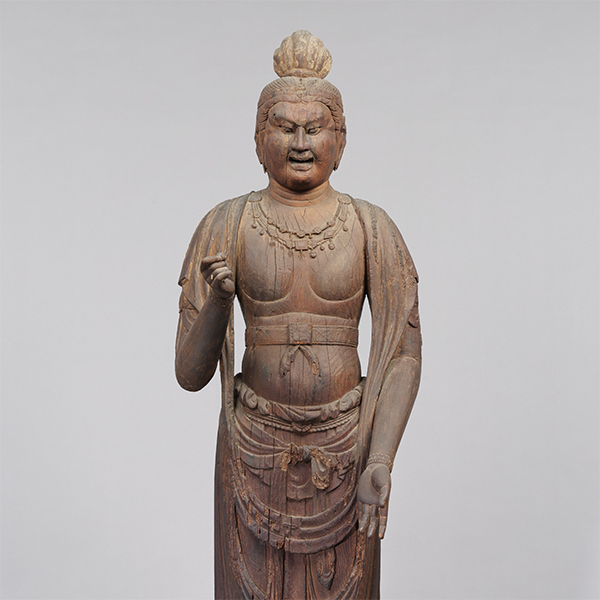Special Thematic Exhibition
The Buddhist Sculptures of Daianji Temple
The Buddhist Sculptures of Daianji Temple
-

The Willow Bodhisattva Kannon (detail), Nara period, 8th century, Daianji Temple, Nara (Important Cultural Property)
Japanese Gallery (Honkan) Room 11
January 2, 2023 (Mon) - March 19, 2023 (Sun)Daianji was Japan’s first temple built by the state. Its predecessor was Daikan Daiji (Great State Temple), with the temple assuming the name Daianji after relocating to the new capital Heijō-kyō (present-day Nara) at the start of the 8th century. Known as one of Nara’s Great Temples during the Nara period (710–794), Daianji flourished as a hub for Buddhist studies. It had a cosmopolitan atmosphere, with priests travelling from India, Vietnam, China, and elsewhere to reside and study on the temple’s spacious grounds. Daianji’s Nara-period Buddhist sculptures are carved from single blocks of wood. They are also characterized by exquisite carving and skillful bodily depictions. As such, they are pioneering examples of the wooden Buddhist sculptures prevalent in Japan from the Heian period (794–1192) onwards. With a focus on these statues, this exhibition explores the appeal of Daianji, the foundation of Japanese Buddhism.
| Designation | Name | Creation/ Excavation/ Provenance |
Period | Acquisition/ Ownership/ Accession Number |
CMT | ||
| Highlight | Important Cultural Property | The Willow Bodhisattva Kannon | Nara period, 8th century | Daianji Temple, Nara | |||
| Highlight | Important Cultural Property | The Bodhisattva Kannon of the Unfailing Lasso | Nara period, 8th century | Daianji Temple, Nara | |||
| Highlight | Important Cultural Property | The Sacred Bodhisattva Kannon | Nara period, 8th century | Daianji Temple, Nara | |||
| Important Cultural Property | The Deva Jikokuten from a Set of Four Heavenly Kings | Nara period, 8th century | Daianji Temple, Nara | ||||
| Important Cultural Property | The Deva Zōchōten from a Set of Four Heavenly Kings | Nara period, 8th century | Daianji Temple, Nara | ||||
| Important Cultural Property | The Deva Kōmokuten from a Set of Four Heavenly Kings | Nara period, 8th century | Daianji Temple, Nara | ||||
| Highlight | Important Cultural Property | The Deva Tamonten from a Set of Four Heavenly Kings | Nara period, 8th century | Daianji Temple, Nara | |||
| Kōbō Daishi | Edo period, 18th century | Daianji Temple, Nara | |||||
| Flat Eave Tile with Double Lotus Leaves | Found at ruins of Daikan Daiji Temple, Nara | Asuka period, 7th century | J-35167 | ||||
| Round Eave Tile with Symmetrical Vines | Found at ruins of Daikan Daiji Temple, Nara | Asuka period, 7th century | J-35353 | ||||
| Flat Eave Tile with Double Lotus Leaves | Found at Daianji Temple, Nara | Nara period, 8th century | J-35218 | ||||
| Round Eave Tile with Symmetrical Vines | Found at Daianji Temple, Nara | Nara period, 8th century | J-35421 | ||||
| Flat Eave Tile with Single Lotus Leaves | Found at Daianji Temple, Nara | Nara period, 8th century | J-35198 | ||||
| Round Eave Tile with Symmetrical Vines | Found at Daianji Temple, Nara | Nara period, 8th century | J-25359-186 | ||||
| Account of the Founding of Daianji Temple and an Inventory of Temple Treasures (Reproduction) | Original: Nara period, 8th century, ink on paper; National Museum of Japanese History, Chiba | Meiji era, 1911 | FS-131 |
